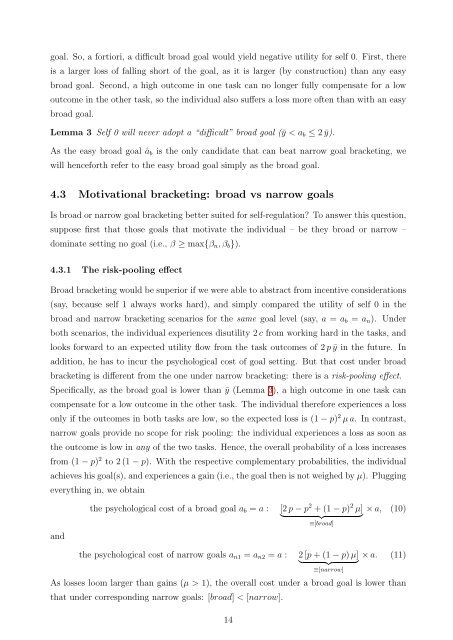Motivational Goal Bracketing - School of Economics and ...
Motivational Goal Bracketing - School of Economics and ...
Motivational Goal Bracketing - School of Economics and ...
Create successful ePaper yourself
Turn your PDF publications into a flip-book with our unique Google optimized e-Paper software.
goal. So, a fortiori, a difficult broad goal would yield negative utility for self 0. First, there<br />
is a larger loss <strong>of</strong> falling short <strong>of</strong> the goal, as it is larger (by construction) than any easy<br />
broad goal. Second, a high outcome in one task can no longer fully compensate for a low<br />
outcome in the other task, so the individual also suffers a loss more <strong>of</strong>ten than with an easy<br />
broad goal.<br />
Lemma 3 Self 0 will never adopt a “difficult” broad goal (¯y < ab ≤ 2 ¯y).<br />
As the easy broad goal âb is the only c<strong>and</strong>idate that can beat narrow goal bracketing, we<br />
will henceforth refer to the easy broad goal simply as the broad goal.<br />
4.3 <strong>Motivational</strong> bracketing: broad vs narrow goals<br />
Is broad or narrow goal bracketing better suited for self-regulation? To answer this question,<br />
suppose first that those goals that motivate the individual – be they broad or narrow –<br />
dominate setting no goal (i.e., β ≥ max{βn, βb}).<br />
4.3.1 The risk-pooling effect<br />
Broad bracketing would be superior if we were able to abstract from incentive considerations<br />
(say, because self 1 always works hard), <strong>and</strong> simply compared the utility <strong>of</strong> self 0 in the<br />
broad <strong>and</strong> narrow bracketing scenarios for the same goal level (say, a = ab = an). Under<br />
both scenarios, the individual experiences disutility 2 c from working hard in the tasks, <strong>and</strong><br />
looks forward to an expected utility flow from the task outcomes <strong>of</strong> 2 p ¯y in the future. In<br />
addition, he has to incur the psychological cost <strong>of</strong> goal setting. But that cost under broad<br />
bracketing is different from the one under narrow bracketing: there is a risk-pooling effect.<br />
Specifically, as the broad goal is lower than ¯y (Lemma 3), a high outcome in one task can<br />
compensate for a low outcome in the other task. The individual therefore experiences a loss<br />
only if the outcomes in both tasks are low, so the expected loss is (1 − p) 2 µ a. In contrast,<br />
narrow goals provide no scope for risk pooling: the individual experiences a loss as soon as<br />
the outcome is low in any <strong>of</strong> the two tasks. Hence, the overall probability <strong>of</strong> a loss increases<br />
from (1 − p) 2 to 2 (1 − p). With the respective complementary probabilities, the individual<br />
achieves his goal(s), <strong>and</strong> experiences a gain (i.e., the goal then is not weighed by µ). Plugging<br />
everything in, we obtain<br />
<strong>and</strong><br />
the psychological cost <strong>of</strong> a broad goal ab = a : [2 p − p 2 + (1 − p) 2 µ] × a,<br />
<br />
≡[broad]<br />
(10)<br />
the psychological cost <strong>of</strong> narrow goals an1 = an2 = a : 2 [p + (1 − p) µ] × a.<br />
<br />
≡[narrow]<br />
(11)<br />
As losses loom larger than gains (µ > 1), the overall cost under a broad goal is lower than<br />
that under corresponding narrow goals: [broad] < [narrow].<br />
14
















